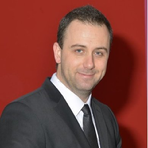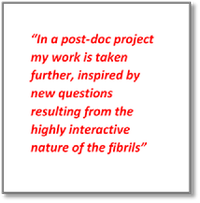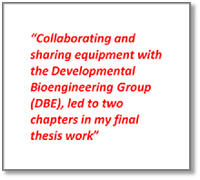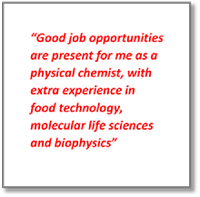 In this thesis the interactions driving the hierarchical self-assembly of α-synuclein is studied. The chemical rules that apply here are essential to be identified, for two very different reasons, Slav Semerdzhiev explains.
In this thesis the interactions driving the hierarchical self-assembly of α-synuclein is studied. The chemical rules that apply here are essential to be identified, for two very different reasons, Slav Semerdzhiev explains.
‘The first one is to better understand the formation of fibrillar assemblies which play an important part in the pathology of Parkinson’s disease. The second reason lies in steering self-assembly processes in more controlled ways, in order to synthesize nanostructured amyloid based materials with tailored properties.’
In this thesis the interactions governing multiscale self-assembly processes were elucidated. ‘We identified possible implications for the pathological formation of higher order amyloid assemblies,’ Slav says. ‘Though identifying these firbrillar clusters is nowadays important to diagnose Parkinson’s disease, the exact role they play, and the way and the conditions under which they are formed, are still unclear.’
These fibrils start to form at the nanometer scale and subsequently assemble into anisotropic clusters of tenth of µm in size, Slav points out. ‘Understanding the molecular interactions properly may shed light on the mechanisms governing the in vivo formation,’ he says. ‘Controlling the interactions – as we have shown in amyloid network – results in interesting fibril multiresponsive materials as well, with tunable properties. That is an aspect I am especially fascinated by, as a material scientist.’
When temperature rises, this special class of biopolymer materials becomes stiffer. ‘This is a counterintuitive phenomenon, when it comes to semi-flexible biopolymer networks,’ Slav Semerdzhiev says. ‘The presence of ions and salts plays an independent extra role in forming fibrillar clusters. Multivalent cations seem to form crosslinks between the fibrils, by bridging the negatively charged fibrils in the amyloid networks.’
Hydrophobic interactions are important for the formation of alpha-synuclein higher order amyloid assemblies, Slav reckons. He demonstrated this by observing the thermo-stiffening effect. ‘In this project we didn’t take various acidities (pH) under consideration yet,’ he says. ‘Here extra research is needed.’
multidisciplinary

Going ‘back and forth’ - unraveling fundamental process phenomena and examining practical material’s properties - suited Slav very well in this PhD project.
‘As a person I like a multidisciplinary approach, learning content and skills along the way,’ he says. ‘My first publication, in ACS Nano, contained both materials science and biological aspects. New possible  explanations are open in this field, including both physicochemical and biological explanation routes. In a post-doc project my work is taken further, inspired by new questions resulting from the highly interactive nature of these fibrils.’
explanations are open in this field, including both physicochemical and biological explanation routes. In a post-doc project my work is taken further, inspired by new questions resulting from the highly interactive nature of these fibrils.’
collaboration

Slav collaborated with various Mesa+ colleagues and experts. ‘Using the scanning Helium ion microscope, for example, was an interesting experience,’ he says. ‘The equipment available at Mesa+ is state of the art, and experts are very willing to collaborate. Also I was happy a colleague was helping me out to perform X-Ray Scattering experiments. Collaborating and sharing equipment with the Developmental Bioengineering Group (DBE), led to two chapters in my final thesis work.’
future
Though Slav’s personal preference is to continue his career in academics, also a job in industry appeals to him.

‘Only if a really good post-doc position is available, I will pursue an academic career,’ he says. ‘However, for me and my family a job in industry provides more certainty in life. I guess good opportunities are present for me as a physical chemist, with extra experience in food technology, molecular life sciences and biophysics.’
‘I try to be open-minded as for my future opportunities, not ruling out less obvious ideas. For example, having worked with XRay Scattering equipment under biological conditions studying proteins, I can be of extra value in researching and designing next generation Biological Small Angle Scattering XRay (SAXs) equipment, meeting needs, demands and wishes clients and consumers come up with.’
